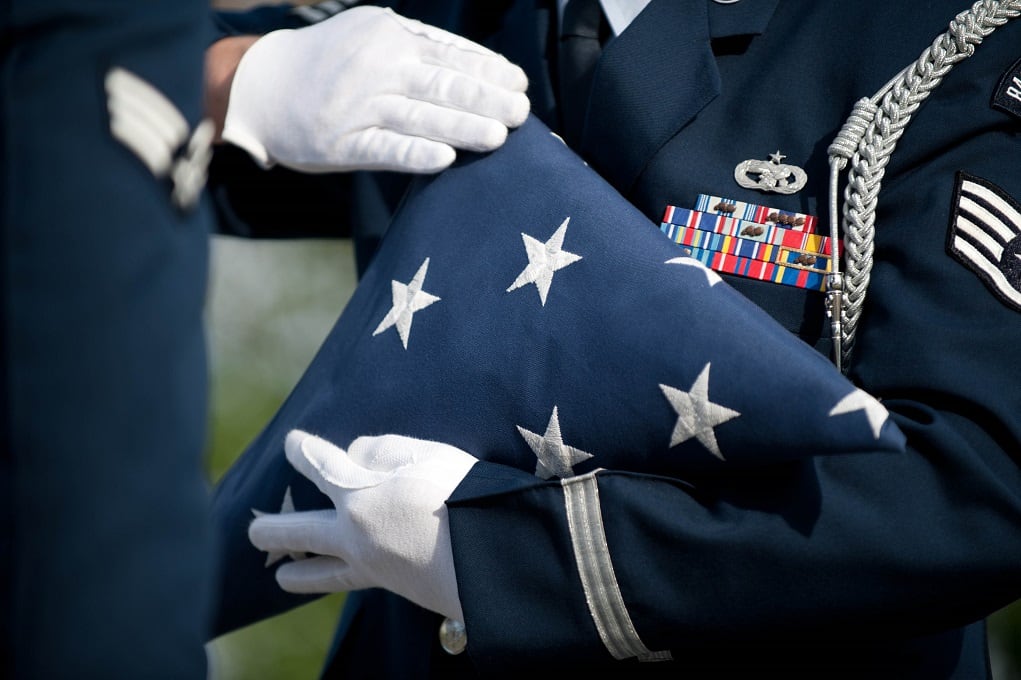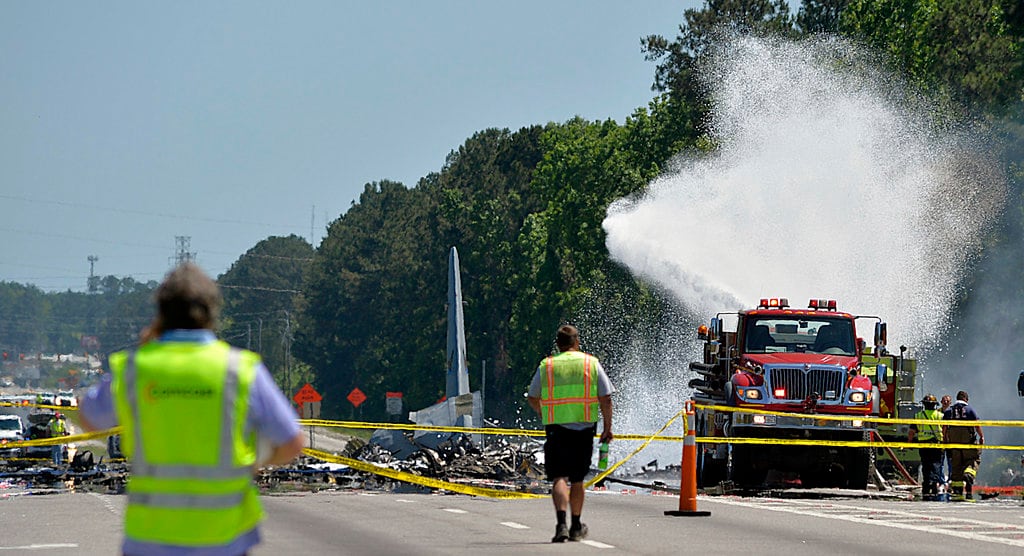A faulty engine, serious maintenance lapses that failed to repair it, and a series of air crew mistakes before and during takeoff led to the horrific WC-130H crash May 2 that killed nine Puerto Rico Air National Guardsmen.
But the Air Force accident investigation board report, which Air Mobility Command posted online Friday night, also exposed troubling morale, manning and resource problems with the 156th Airlift Wing, and a possible “culture of complacency” that may have led maintainers to cut corners.
The WC-130 was to be flown from the Hilton Head International Airport in Savannah, Georgia, to the 309th Aerospace Maintenance and Regeneration Group at Davis-Monthan Air Force Base in Arizona — better known as the Boneyard — to be removed from service. But it crashed less than two minutes after takeoff, at about 11:27 a.m., and killed all nine aboard.
The report said that the first engine’s revolutions-per-minute began fluctuating during the takeoff roll, and a few seconds before the aircraft’s nose wheel left the ground, the engine’s RPM and torque significantly decayed. The WC-130 began pulling to the left, and veered so sharply left when the nose wheel lifted off that the plane nearly departed the runway.
The plane’s pilot, Maj. José R. Román Rosado, made an unspecific comment about something being wrong with the plane as he took control of the yoke about the time the nose wheel lifted off — but he did not abort the takeoff. He banked the plane right, away from the faulty engine, once it was airborne to stay aligned with the runway’s centerline.
The flight manual directs an aircrew facing an engine failure during takeoff to raise the landing gear while accelerating, and then, once the landing gear is up and the plane is at sufficient airspeed, retract flaps, and continue accelerating to a speed where the plane can climb with three engines. However, the report said a member of the aircrew incorrectly called for flaps to be retracted only seconds after becoming airborne, during the bank right and before the landing gear had been raised. Co-pilot 1st Lt. David Albandoz repeated the call for flap retraction.
RELATED

Rosado ordered the flaps to stay at 50 percent and told Albandoz to raise landing gear, but he never issued a follow-up order to retract the flaps, which would have been standard procedure. This would have reduced drag and allowed the aircraft to accelerate, giving the pilots more control.
The faulty engine partially regained power, but soon lost significant thrust once again, at which point Rosado ordered the engine to be shut down, which followed proper procedures.
Instead of continuing to accelerate to a three-engine climb speed, Rosado banked left, into the shut-down engine. This too was the opposite of what the flight manual directs in such a situation, the report said.
The plane had enough airspeed to keep flying during the bank, the report said. But Rosado increasingly turned the rudder to the left, which he was not supposed to do, until the plane skidded. Its left wing lost lift and stalled and the plane crashed on a highway about 1.5 miles from the airport.
The report said that Rosado also did not brief the crew on emergency action procedures during the pre-flight checklist, instead saying that “everything else remains the same,” indicating that what he said on a previous flight still applied. However, it is understood that pilots can only skip such briefings when the crew conducts multiple takeoffs or landings in the same day, and it had been several days since the crew flew and last heard those emergency action procedures.
The report also cited a “breakdown in visual scan,” and said flight engineer Master Sgt. Mario Braña failed to recognize the loss of power to the engine and call for the takeoff to be aborted. The plane’s pilots and navigator, Maj. Carlos Pérez Serra, also failed to scan the recently maintained and problematic engine’s performance during takeoff, the report said.
Rosado was an experienced pilot who had flown for nearly 14 years, had nearly 3,500 hours flying the C-130 and its variants, and was “regarded by many as the best pilot in the unit,” the report said.
Also killed in the crash were mechanic Senior Master Sgt. Jan Paravisini, Master Sgt. Jean Audriffred, Master Sgt. Víctor Colón, loadmaster Master Sgt. Eric Circuns, and Senior Airman Roberto Espada.
Maintenance problems and ‘culture of complacency’
The report details several mistakes and oversights made by the maintainers who worked on that engine. When that airplane was flown from Puerto Rico to Savannah April 9, its flight crew reported problems with that engine’s RPMs dropping to 96 percent.
Two unnamed propulsion specialists from the 156th Maintenance Group worked on the plane April 24, along with two crew chiefs, the report said. The propulsion specialists were supposed to use a precision tachometer when troubleshooting the engine’s RPM problem, but theirs was unavailable. They borrowed another one, but its plugs were different and they didn’t realize it had an adapter. So they skipped that step and continued without taking precise tachometer readings.

The maintainers instead used the cockpit’s RPM gauge to adjust the engine up to what they believed was 99 percent. They knew the engine should operate at 100 percent, but if they made the adjustment they thought would get it to that level, they would have to conduct a third test on the engine to verify the results. So they signed off on it, believing 99 percent was good enough because the “aircraft is going to the Boneyard anyway,” as one was heard saying on the cockpit voice recorder.
In fact, the engine never reached 99 percent. The digital flight data recorder showed that the faulty engine never reached sustained RPMs above 96.8 percent, and had significant oscillations between 95 and 98 percent, the report said.
The investigators highlighted problems with the 156th that “may be indicative of a climate and culture of complacency." That climate, the report said, “could have shaped the attitudes and actions of the mishap maintainers” to ignore standard procedure and assume 99 percent was good enough, without realizing the danger of those violations.
The 156th was suffering from “a certain degree of apathy and low morale” that “stemmed from a lack of cohesive mission for a wing that flies non-combat coded aircraft,” the report said. It had a problem with aircraft availability, which made it hard to keep aircrew properly trained and qualified. Poor morale also drove some people to leave the 156th, worsening manning shortfalls in vital positions that remained unfilled for long periods of time.
The 156th has some of the oldest C-130s in the Air Force, the report said, and its airmen believe their wing “is an afterthought” to the Air Force. Because it’s planes aren’t combat-coded, airmen don’t feel like they’re part of the total force, and don’t have a direct connection to a mission.
In fact, none of the senior leaders interviewed as part of the investigation “could accurately describe the mission of the unit.”
Several buildings at Muñiz Air National Guard Base, the 156th’s home base, were damaged during Hurricane Maria in 2017, and there was a lack of initiative or urgency to repair or replace them. This, combined with the overall age and poor condition of the facilities at Muñiz, cost the 156th important workspace necessary to repair aircraft. And the wing had a hard time getting necessary spare parts from the continental United States, which worsened repair times and led to lower mission-capable rates for aircraft.
Official processes appeared to be broken, the report said. Paperwork for the crashed aircraft often was either incomplete or missing altogether, and dates on different documents sometimes did not line up.
The report also said that many members of the 156th Maintenance Group lacked the knowledge, risk assessment and error management skills necessary for their jobs. Most who were interviewed could not say whether they had attended maintenance resource management training, or they weren’t sure what was in that training. The propulsion specialists didn’t know there were troubleshooting guides in the manuals on-board the aircraft and instead used their back-shop manuals. One of the crew chiefs who worked on the plane couldn’t define his roles and responsibilities during a maintenance engine run.
The four maintainers who worked on the plane “showed a distinct lack of motivation to ensure engine one was operationally ready for flight,” the report said.
Stephen Losey is the air warfare reporter for Defense News. He previously covered leadership and personnel issues at Air Force Times, and the Pentagon, special operations and air warfare at Military.com. He has traveled to the Middle East to cover U.S. Air Force operations.




